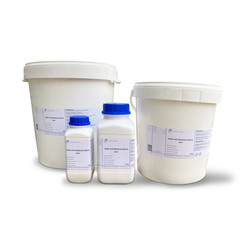You have no items in your shopping cart
Oxalic acid
Oxalic acid is an organic compound with the formula C2H2O4. It is a white crystalline solid that forms a colorless solution in water. Its condensed formula is HOOCCOOH, reflecting its classification as the simplest dicarboxylic acid.
Its acid strength is much greater than that of acetic acid. Oxalic acid is a reducing agent and its conjugate base, known as oxalate (C
2O2−
4), is a chelating agent for metal cations. Typically, oxalic acid occurs as the dihydrate with the formula C2H2O4·2H2O.
It occurs naturally in many foods, but excessive ingestion of oxalic acid or prolonged skin contact can be dangerous.
Its name comes from the fact that early investigators isolated oxalic acid from flowering plants of the genus Oxalis, commonly known as wood-sorrels.
Applications
About 25% of produced oxalic acid will be used as a mordant in dyeing processes. It is used in bleaches, especially for pulpwood. It is also used in baking powder and as a third reagent in silica analysis instruments.
Cleaning
Oxalic acid's main applications include cleaning or bleaching, especially for the removal of rust (iron complexing agent). Its utility in rust removal agents is due to its forming a stable, water-soluble salt with ferric iron, ferrioxalate ion.
Extractive metallurgy
Oxalic acid is an important reagent in lanthanide chemistry. Hydrated lanthanide oxalates form readily in very strongly acidic solutions in a densely crystalline, easily filtered form, largely free of contamination by nonlanthanide elements. Thermal decomposition of these oxalate gives the oxides, which is the most commonly marketed form of these elements.
Niche uses
Oxalic acid is used to clean minerals.
Oxalic acid is sometimes used in the aluminum anodizing process, with or without sulfuric acid. Compared to sulfuric acid anodizing, the coatings obtained are thinner and exhibit lower surface roughness

